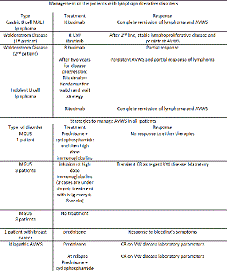
Contributions
Abstract: EP571
Type: E-Poster Presentation
Session title: Bleeding disorders (congenital and acquired)
Background
Acquired Von Willebrand Syndrome (AVWS) is a rare acquired coagulopathy, often associated to an underlying disorder (lymphoproliferative, cardiovascular, myeloproliferative, neoplastic, and autoimmune disorders). The diagnosis is not easy and relies on a negative familial and personal clinical hemorrhagic history and a late onset in life of bleeding symptoms, associated with a laboratory pattern for Von Willebrand Disease (VWD).
Aims
Aim of this study is to describe the experience on diagnosis and management of AVWS patients (pts) in two Italian centers.
Methods
Between 2004-2020 we have diagnosed and managed 14 pts [8F, 6M; median age 62.45 years (45.4-85.9)] affected by AVWS. Determination of coagulation parameters, including FVIII, were carried out on an automatic coagulometer (ACL Top 700, Werfen). VWF:antigen (VWF:Ag) and VWF:activity (VWF:RCo) were measured by chemiluminescence assays (HemosIL AcuStar, Werfen). VWF propeptide (VWFpp) level was measured by ELISA immunoassay (Sanquin, Amsterdam, NL). The screening for VWF:RCo inhibitor was made utilizing mixing studies
Results
Reasons for diagnosis were: recent onset of bleeding symptoms in 9 pts, increased aPTT in 5. At diagnosis, for all pts we observed these results: median VWF:Ag 15%, range 1.6-51% (n.v. blood group 0: 41-101%; no 0: 50-130%); median VWF:RCo 13%, range <6.25-33% (n.v. blood group 0: 41-97%; no 0: 52-124); median FVIII:C 19.2%, range 2.1-53% (n.v.58-130%)]. VWF:RCo inhibitor was searched in 4 cases: 3 were negative, 1 positive. We could study VWFpp and multimers in 9 pts. Except VWFpp median level (81.5%, range 42.9-154.3) all other VWF-related median parameters (VWF:Ag, VWF:RCo and FVIII:C) were significantly reduced in patients, respectively 7.3%, 4.5% and 15.2%. VWFpp/VWF:Ag ratio was significantly higher in all 9 patients: 20 (n.v.<3). Multimers were absent in 6 pts, normal in 2; in 1 patient were present just low molecular weight multimers. All the pts did not have either a family or past personal history of bleeding disorders/symptoms. The spontaneous hemorrhagic events presented at diagnosis and during follow up were: GI and gum bleeding, muscle hematomas, hematuria, ecchymoses, epistaxis. Three pts bled after dental extractions/procedures, although they were prophylactically treated with VWF/FVIII concentrate. Desmopressin, Tranexamic Acid, VWF/FVIII concentrate and recombinant FVIII were used as prophylaxis or treatment of bleedings in all pts, with variable responses on clinical symptoms. Thirteen/14 cases showed a concomitant disorder: 1 gastric B cell MALT lymphoma, 1 indolent B cell lymphoma, 7 MGUS, 2 Waldenstrom Disease and 2 patients with breast cancer and concomitant MGUS. In one case AVWS was idiopathic. In the table, therapies either for underlying disorders if present or AVWS and outcomes are shown.

Conclusion
AVWS is a rare syndrome, probably underdiagnosed because unrecognized. AVWS must be suspected whenever a patient presents with a late onset in life of bleeding symptoms associated to laboratory characteristics compatible with VWD. The VWFpp/VWF:Ag ratio could be a valuable biomarker to be considered in these complicated diagnoses. It is mandatory to search for concomitant diseases.
Keyword(s): Acquired von Willebrand syndrome
Abstract: EP571
Type: E-Poster Presentation
Session title: Bleeding disorders (congenital and acquired)
Background
Acquired Von Willebrand Syndrome (AVWS) is a rare acquired coagulopathy, often associated to an underlying disorder (lymphoproliferative, cardiovascular, myeloproliferative, neoplastic, and autoimmune disorders). The diagnosis is not easy and relies on a negative familial and personal clinical hemorrhagic history and a late onset in life of bleeding symptoms, associated with a laboratory pattern for Von Willebrand Disease (VWD).
Aims
Aim of this study is to describe the experience on diagnosis and management of AVWS patients (pts) in two Italian centers.
Methods
Between 2004-2020 we have diagnosed and managed 14 pts [8F, 6M; median age 62.45 years (45.4-85.9)] affected by AVWS. Determination of coagulation parameters, including FVIII, were carried out on an automatic coagulometer (ACL Top 700, Werfen). VWF:antigen (VWF:Ag) and VWF:activity (VWF:RCo) were measured by chemiluminescence assays (HemosIL AcuStar, Werfen). VWF propeptide (VWFpp) level was measured by ELISA immunoassay (Sanquin, Amsterdam, NL). The screening for VWF:RCo inhibitor was made utilizing mixing studies
Results
Reasons for diagnosis were: recent onset of bleeding symptoms in 9 pts, increased aPTT in 5. At diagnosis, for all pts we observed these results: median VWF:Ag 15%, range 1.6-51% (n.v. blood group 0: 41-101%; no 0: 50-130%); median VWF:RCo 13%, range <6.25-33% (n.v. blood group 0: 41-97%; no 0: 52-124); median FVIII:C 19.2%, range 2.1-53% (n.v.58-130%)]. VWF:RCo inhibitor was searched in 4 cases: 3 were negative, 1 positive. We could study VWFpp and multimers in 9 pts. Except VWFpp median level (81.5%, range 42.9-154.3) all other VWF-related median parameters (VWF:Ag, VWF:RCo and FVIII:C) were significantly reduced in patients, respectively 7.3%, 4.5% and 15.2%. VWFpp/VWF:Ag ratio was significantly higher in all 9 patients: 20 (n.v.<3). Multimers were absent in 6 pts, normal in 2; in 1 patient were present just low molecular weight multimers. All the pts did not have either a family or past personal history of bleeding disorders/symptoms. The spontaneous hemorrhagic events presented at diagnosis and during follow up were: GI and gum bleeding, muscle hematomas, hematuria, ecchymoses, epistaxis. Three pts bled after dental extractions/procedures, although they were prophylactically treated with VWF/FVIII concentrate. Desmopressin, Tranexamic Acid, VWF/FVIII concentrate and recombinant FVIII were used as prophylaxis or treatment of bleedings in all pts, with variable responses on clinical symptoms. Thirteen/14 cases showed a concomitant disorder: 1 gastric B cell MALT lymphoma, 1 indolent B cell lymphoma, 7 MGUS, 2 Waldenstrom Disease and 2 patients with breast cancer and concomitant MGUS. In one case AVWS was idiopathic. In the table, therapies either for underlying disorders if present or AVWS and outcomes are shown.

Conclusion
AVWS is a rare syndrome, probably underdiagnosed because unrecognized. AVWS must be suspected whenever a patient presents with a late onset in life of bleeding symptoms associated to laboratory characteristics compatible with VWD. The VWFpp/VWF:Ag ratio could be a valuable biomarker to be considered in these complicated diagnoses. It is mandatory to search for concomitant diseases.
Keyword(s): Acquired von Willebrand syndrome


